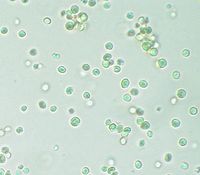
Photo from wikipedia
Phytoplankton, with an estimated 30 000 to 1 000 000 species clustered in 12 phyla, presents a high taxonomic and ecophysiological diversity, reflected by the complex distribution of pigments among… Click to show full abstract
Phytoplankton, with an estimated 30 000 to 1 000 000 species clustered in 12 phyla, presents a high taxonomic and ecophysiological diversity, reflected by the complex distribution of pigments among the different algal classes. High performance liquid chromatography is the gold standard method for qualitative and quantitative analysis of phytoplankton pigments in seawater and culture samples, but only a few pigments can be used as robust chemotaxonomic markers. A major challenge is thus to identify new ones, characteristic of a strain, species, class or taxon that cannot be currently identified on the basis of its pigment signature. Using an optimized extraction process coupled to a HPLC de-replication strategy, we examined the pigment composition of 37 microalgae strains, representative of the broad taxonomic diversity of marine and freshwater species (excluding cyanobacteria). For each species, the major pigments already described were unambiguously identified. We also observed the presence of several minor unidentified pigments in each chromatogram. The global analysis of pigment compositions revealed a total of 124 pigments, including 98 pigments or derivatives unidentified using the standards. Absorption spectra indicated that 35 corresponded to chlorophyll/porphyrin derivatives, 57 to carotenoids and six to derivatives having both spectral signatures. Sixty-one of these unidentified or new carotenoids and porphyrin derivatives were characteristic of particular strains or species, indicating their possible use as highly specific chemotaxonomic markers capable of identifying one strain out of the 37 selected. We developed a graphical analysis using Gephi software to give a clear representation of pigment communities among the various phytoplankton strains, and to reveal strain-characteristic and shared pigments. This made it possible to reconstruct the taxonomic evolution of microalgae classes, on the basis of the conservation, loss, and/or appearance of pigments.
Journal Title: PLoS ONE
Year Published: 2017
Link to full text (if available)
Share on Social Media: Sign Up to like & get
recommendations!